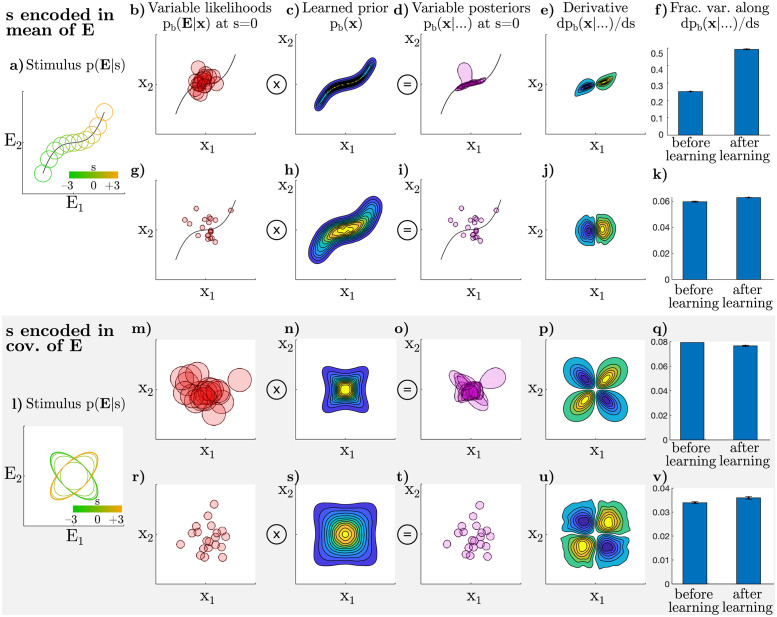Fig 4.
Numerical simulation of how variable likelihoods both determine and interact with the shape of the prior. Top two rows: mean of observations E depends on s as shown in panel (a). Bottom two rows (gray background): covariance of observations E depends on s as shown in panel (l). a) In this setup, observations are noisy, reflecting both internal and external noise. We set E to be two-dimensional, drawn from pe(E|s), a Gaussian whose mean depends on s (black curve). Ellipses indicate one standard deviation of pe(E|s). b) Now visualizing the space of latent variables, x, which we also set to be two-dimensional, such that the brain’s internal model assumes pb(E|x) is Gaussian, centered on x, with the shown variance. Each red circle shows a single contour of the likelihood, as a function of x, for a different E drawn from the pe(E|s = 0) set of observations. c) After learning, the prior is extended along the curve that parameterizes the mean of x, such that the brain’s distribution on observations, pb(E) marginalized over x, approximates the true distribution on observations, pe(E) marginalized over s (Methods). d) Posteriors in the zero-signal or s = 0 case, given by the product of the likelihoods in (b) with the prior in (c). e) The direction in distribution-space corresponding to differential covariance in neural-space is the dpb/ds-direction, averaged over instances of noise. f) The fraction of variance in distribution-space (d) along the dpb/ds-direction. After learning, a larger fraction of the total variance is in the dpb/ds-direction, corresponding to increased differential correlations in neural space. g-k) Identical to (b) through (f), except that the brain’s internal model is more precise relative to the variations in observations E, modeled as smaller variance for pb(E|x). This has the effect of reducing the effect of learning a new prior in panel (k). l-v) Identical to (a) through (k), except that here, s parameterizes the covariance of observations E rather than their mean. This is analogous to, for example, an orientation-discrimination task with randomized phases, such that the average stimulus in pixel-space is identical for both categories. While panel (v) (precise model) shows a slight increase in variance in the dpb(x|…)/ds direction, consistent with (f) and (k), panel (q) (imprecise model) shows a slight decrease.

